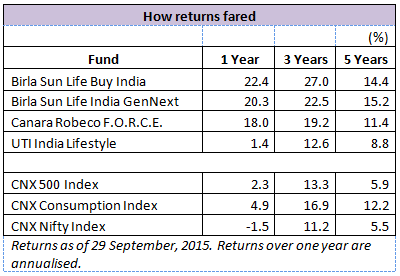A boost to consumption is one of the several positive outcomes of Tuesday’s sharp rate cut. It adds impetus to the nascent recovery in consumption, and growth will be quicker on the consumption front than on investments. As a result, over the next one to two years, the consumer theme can play out well.
 Reports put out by CRISIL and ICRA both point to consumption expenditure driving the GDP growth over this fiscal year and the next. This apart, RBI’s June Consumer Confidence Survey pointed to expectations of higher spending in the future, with 86 per cent of respondents expecting their spending to rise over the next one year. A sustained intention to spend also reflects in global consumer tracking agency, Nielsen’s, measures, which peg India’s consumer confidence at its highest level (in August 2015) since 2011.
Reports put out by CRISIL and ICRA both point to consumption expenditure driving the GDP growth over this fiscal year and the next. This apart, RBI’s June Consumer Confidence Survey pointed to expectations of higher spending in the future, with 86 per cent of respondents expecting their spending to rise over the next one year. A sustained intention to spend also reflects in global consumer tracking agency, Nielsen’s, measures, which peg India’s consumer confidence at its highest level (in August 2015) since 2011.
So, what can drive consumption pick-up over the next couple of years?
One, the biggest factor that restrained consumers from loosening their purse strings was high inflation. This has cooled off significantly now, within the Reserve Bank’s 6 per cent January 2016 target. Cheap inputs will keep a lid on the prices of goods such as cars, white goods, FMCGs, and so on.
True, the patchy monsoons could result in higher prices of some agricultural crops. But as of now, sowing area is higher than last year, Minimum Support Prices (barring paddy and ragi) have not been hiked by a significant margin, crude oil prices remain subdued, and there has been lower outgo on rural employment programmes. All these indicate that inflation is unlikely to move back into the double-digits that prevailed for years. The RBI estimates inflation to move up by 100 basis points over the 2015-16 base case scenario, if food prices rise.
Two, the 125 basis-point cut by the RBI so far should, at some point, translate into lower bank lending rates. Cheaper credit can induce customers to move back into the spending mode, helping sectors such as consumer durables and automobiles. Passenger car sales, in fact, have already revived. Their sales, which had shrunk around 6 per cent in 2013-14, bounced back to a growth of 4 per cent in 2014-15. Urban consumption, which had been weak so far, is therefore set to revive. The September 2015 Monetary Policy Report also explains the improving fundamentals for urban consumption. On the other hand, rural demand may not grow at the pace it has been hitherto, with rural wage growth decelerating from 2014.
Three, both the Seventh Pay Commission (whose report is due next month), and the One Rank One Pension payouts can directly put money in consumer hands. The Sixth Pay Commission, just for an example, had resulted in a near-doubling of pay and allowances (for Central Government employees alone) between 2007-08 and 2011-12 to Rs. 1,66,792 crore. The cost of OROP has been stated as Rs. 10,000 crore initially, which can rise in the succeeding years.
Four, as far as the markets go, sectors heavily dependent on economic growth, such as infrastructure and capital goods, ran up in the first leg of the rally that began in 2013. But hopes of big reforms have not panned out as expected, and revival is a long way away. It is also dependent on government spending. So, with valuations high and no earnings growth in sight, consumer sectors may return to be market favourites.
This said, how can you make the most of the consumption revival?
How to play the theme
Consumption, as a theme, has several sectors attached to it. Banking is one, especially with retail lending forming an increasing share of bank loan books. Automobiles, media, entertainment, FMCGs, textiles, retail, hotels, and education, are all sectors that ride on the consumption pick-up story.
There are consumer-focused funds which can be invested in. These funds hold higher risk, due to their focus on a particular theme, and because they can invest across market capitalisations.

Birla Sun Life Buy India Fund, for example, focuses on consumer-driven businesses, including healthcare. This is the most comprehensive consumer-themed fund of those available. The fund’s latest portfolio sports a good mix of sectors and stocks, with financials and automobiles forming the heaviest weights. Other sectors include services such as travel, consumer durables, auto ancillaries, and so on. Picks such as Hitachi Home & Life Solutions, Zee Entertainment, Maruti Suzuki, and Colgate Palmolive have all worked well for the fund. Against the benchmark BSE 200’s 5.6 per cent, the fund has clocked five year returns of 26.9 per cent. On an annual rolling return basis, the fund has beaten the BSE 200 over 90 per cent of the time in the past seven years.
Another variation on the consumer theme from the same AMC is the Birla Sun Life Gen Next Fund, which focuses on sectors that cater more towards products and services targeted towards the younger generation. Besides finance, FMCG holds the highest portfolio weight currently, where valuations are already high. Though it is benchmarked to the Nifty index, it is far broader with a much lower average market capitalisation. It, however, scores better than its peers on risk-adjusted returns, and also has a lower standard deviation.
The third fund is the UTI India Lifestyle Fund, which plays on changing lifestyles due to demographic shifts. The fund, however, has starkly underperformed other consumer-themed funds. Holding in software, and some cyclical stocks hurt its performance; its consistency is also poorer than peers, beating the CNX 500 (its benchmark) 70 per cent of the time in a seven-year period.
The fourth fund, Canara Robeco F.O.R.C.E., has a mandate similar to that of Birla Sun Life Buy India, but has a mismatched benchmark in the Nifty. 2013 was also a year of underperformance for the fund, and it holds a lower risk-adjusted return than both Birla funds. The fifth fund is Sundaram Rural India Fund, but with urban demand likely to outpace rural growth, and the slowing growth in rural wages, the restricted focus may not help now.
It’s possible to benefit from the consumer theme even without themed funds. Diversified funds, in their own sector churn, will up exposure to consumer sectors as promise grows. Funds such as BNP Paribas Equity, Franklin India High Growth, and Religare Invesco Mid N Small Cap from our Select Funds list, for example, have good exposure to sectors such as financials, automobiles, auto ancillaries, media and communications, and telecom.
We do not have any recommendations on the theme funds mentioned above.
FundsIndia’s Research team has, to the best of its ability, taken into account various factors – both quantitative measures and qualitative assessments, in an unbiased manner, while choosing the fund(s) mentioned above. However, they carry unknown risks and uncertainties linked to broad markets, as well as analysts’ expectations about future events. They should not, therefore, be the sole basis of investment decisions. To know how to read our weekly fund reviews, please click here.








Nice selection of MF schemes based upon consumption based theme.
Nice selection of MF schemes based upon consumption based theme.